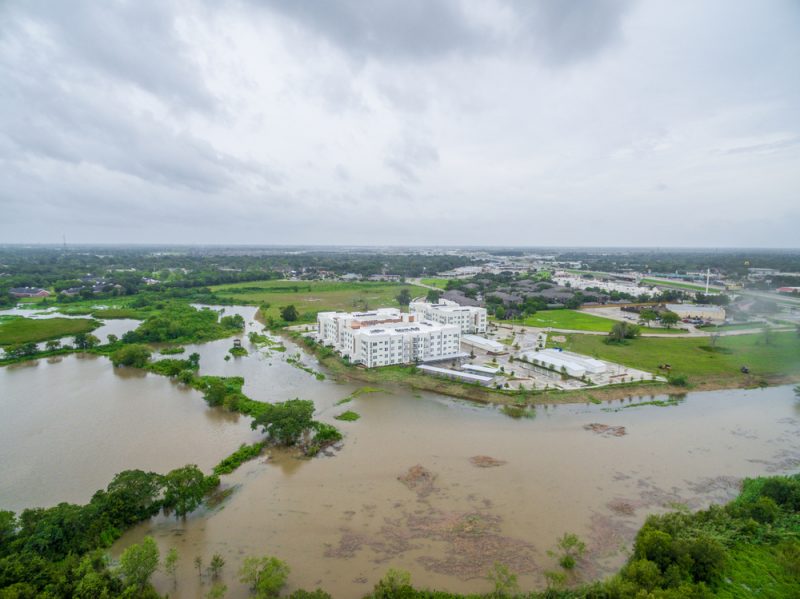Texas electric grid remains stable in wake of Hurricane Harvey, but oil industry at risk

While utilities work to rectify power outages, the damage Hurricane Harvey, now a tropical storm, has inflicted on the U.S. energy industry could lead to serious costs in the days ahead.
The storm continues to hammer the eastern parts of the state, with an additional 7 to 13 inches of rain expected to fall through Friday, and thousands of displaced residents headed for shelters.
Despite widespread transmission outages near Corpus Christi and Victoria, the Electric Reliability Council of Texas (ERCOT), which operates the electric grid and manages the deregulated market for 75 percent of the state, said it continues to work with transmission and generation owners to protect the overall reliability of the grid.
“The ERCOT system overall remains stable,” ERCOT spokesman Robbie Searcy told Daily Energy Insider.
She noted that further updates on the grid will continue to be made available through a webpage ERCOT set up specifically for its Harvey response. ERCOT has also noted, however, that system restoration times will vary depending on the extent of damage and location of outages in the days ahead.
“Damage assessments are underway, and restoration progress is being made in areas that can be accessed safely,” said Edison Electric Institute (EEI) President Tom Kuhn. “At this point, nearly 10,000 workers are dedicated to the response and recovery effort. This includes crews, lineworkers, and support personnel from the impacted companies and mutual assistance crews from at least 19 states across the country. Additional resources are ready to mobilize to assist if needed to further support restoration.”
EEI said the electric power industry continues to coordinate with the federal government to manage the damage and response effort. On Monday, Department of Energy Secretary Rick Perry held a call for the third day in a row with the CEOs of companies impacted by Harvey to ensure that all resource needs are met and that there is continued coordination.
As of this morning, more than 272,000 Texans were suffering power outages, according to the U.S. Department of Energy (DOE).
AEP Texas, the most significantly impacted utility, reports that about 133,600 customers in the Coastal Bend area remained without power as of noon Tuesday as a result of Hurricane Harvey.
“We are working to reduce the number of hazard tickets; however, we’re facing hundreds of downed power lines, as well utility poles damaged by the storm,” said Tom Coad, AEP Texas vice president of Distribution Region Operations. “Currently there are nearly 4,400 hazard tickets still being addressed throughout the Coastal Bend area and approximately 2,600 in Corpus Christi alone. We know that customers are concerned about these hazards, and we are trying to get each one as quickly as possible,” Coad said in a written statement.
AEP Texas estimates that at least 2,100 utility poles and 55 transmission structures were damaged or knocked down by the storm.
CenterPoint Energy has noted the difficulty with addressing impacted customers in downtown Houston until the floodwaters recede and experts can tackle potentially damaged electric infrastructure.
“We have restored power to more than 580,000 customers since Harvey began to impact our service territory on Friday,” CenterPoint Energy said in a written statement, adding that 96 percent of its customers have power.
“In some areas, we are proactively taking service off the grid in order to avoid long-term damage to infrastructure, which could potentially result in a longer restoration time,” CenterPoint Energy said.
CenterPoint has also said it is utilizing smart meters to track customers impacted by power outages.
Meanwhile, Texas ports remain closed and state of disasters remain in effect for more than two dozen counties.
The oil industry near the Texas Gulf Coast has also taken a beating from the storm, in a case that could have serious ramifications for the rest of the country.
Thus far, 11 oil refineries have shut down around Houston and Corpus Christi, with operations from Exxon Mobil, Valero, Citgo, Shell, and Phillips 66 all affected. Retail gas station outages in the area are reported, and as of Monday, 19 percent of oil production — as well as 18 percent of natural gas production — from the Gulf of Mexico have been shut-in, according to DOE.
That represents a sizable downturn from a region that produces more than 25 percent of the nation’s gasoline. Already, 11 percent of the U.S. refining capacity has been knocked out. Analysts expect such moves to lead to spikes in fuel pricing and potential shortages, though the DOE has stated that overall stocks of gasoline and distillate in the region are at or above the top end of a five-year range.
Further complicating matters is that the federal government has not yet announced whether it will release barrels of oil or refined products from the nation’s Strategic Petroleum Reserve to aid the situation. That reserve holds nearly 680 million barrels of oil, which could become critical if Texas refineries remain offline for any length of time — a danger that could become reality if their pump systems become swamped by the massive influx of water.
The National Weather Service reported that more than 30 inches of rain fell in the Houston area in a mere 48 hours.
It is “one of the largest disasters America has ever faced,” according to Texas Gov. Greg Abbott. Surveying some of the ongoing problems for himself, President Donald Trump arrived in Texas on Monday to tour Corpus Christi and Austin.
